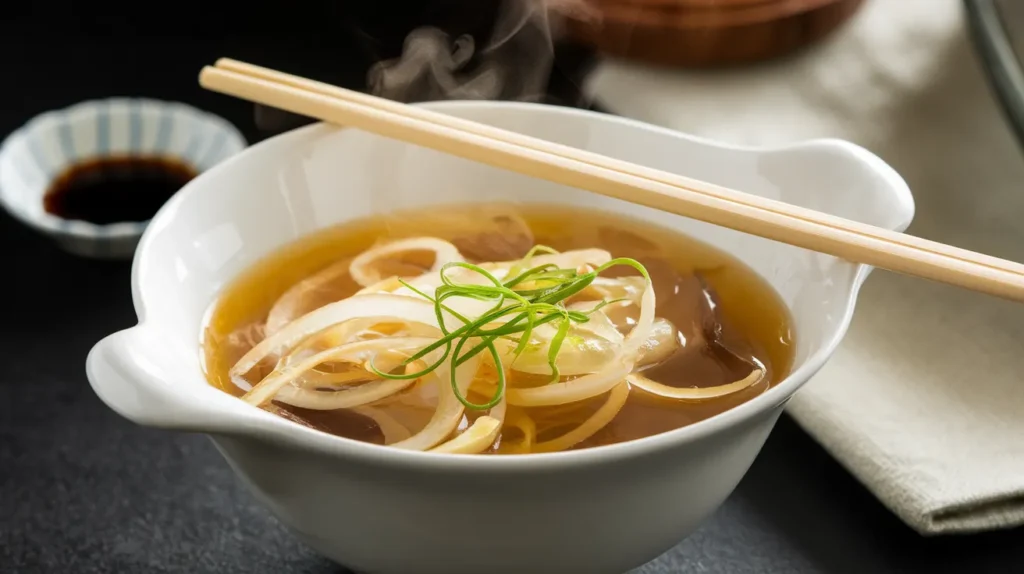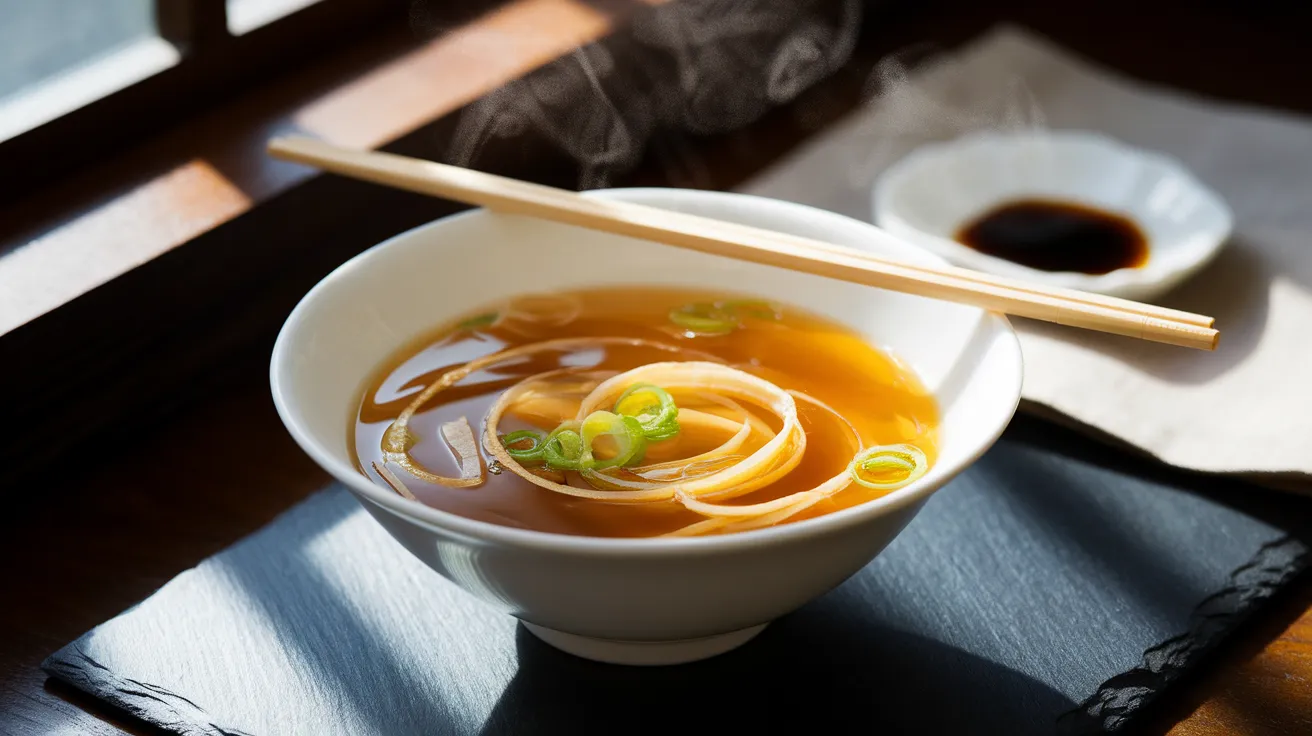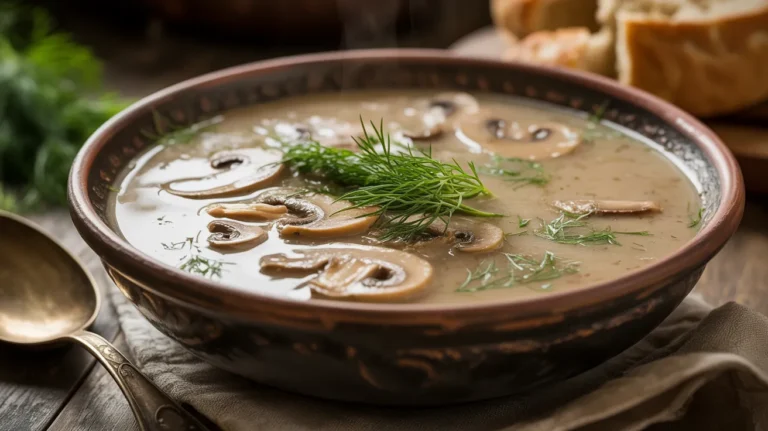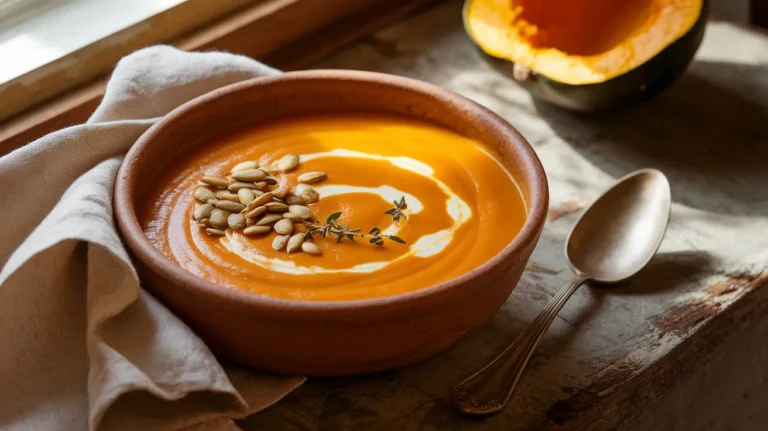This Japanese Clear Onion Soup transforms humble onions into liquid gold with a delicate broth that’s both comforting and elegant. Perfect for starting any meal, this Japanese Clear Onion Soup recipe captures the essence of steakhouse-style soup with authentic flavors you can master at home.
SERVES: 4 | PREP: 15 MIN | COOK: 25 MIN | TOTAL: 40 MIN
What Makes This Japanese Clear Onion Soup Special
You know that soup they serve at Japanese steakhouses?
The one that’s so good you want three bowls before your meal even arrives?
This is that soup—and it’s shockingly easy to make at home.
The secret isn’t complicated ingredients or fancy techniques. It’s all about building layers of flavor through proper onion preparation and a crystal-clear broth that tastes like it simmered for hours.
Ingredients You’ll Need
For the Broth Base
| Ingredient | Amount |
|---|---|
| Beef broth | 6 cups |
| Chicken broth | 2 cups |
| Soy sauce | 3 tablespoons |
| Fresh ginger (sliced) | 2-inch piece |
| Garlic cloves | 3 cloves |
For the Soup
| Ingredient | Amount |
|---|---|
| Yellow onions | 2 large |
| White mushrooms | 8 ounces |
| Green onions | 4 stalks |
| Toasted sesame oil | 1 teaspoon |
| Salt | To taste |
| White pepper | ¼ teaspoon |
Optional Garnish
| Ingredient | Amount |
|---|---|
| Fried onion crisps | ¼ cup |
| Fresh cilantro | 2 tablespoons |
Step-by-Step Cooking Instructions
Phase 1: Preparing Your Aromatics (5 minutes)
Step 1: Peel your ginger using the edge of a spoon rather than a knife—this removes just the skin and wastes less of the valuable flesh underneath. Slice it into thin coins about ⅛-inch thick. These thin slices release flavor faster into your broth.
Step 2: Smash your garlic cloves with the flat side of your knife before peeling. This bruising releases the aromatic oils that make your Japanese Clear Onion Soup smell incredible. Leave the cloves whole after smashing—you’ll strain them out later.
Step 3: Slice your yellow onions pole-to-pole (from root to stem end) into thin strips, about ¼-inch wide. This specific cut direction keeps the onions from falling apart during cooking and creates those beautiful translucent ribbons you see in restaurant versions.
Step 4: Clean your mushrooms with a damp paper towel—never rinse them under water because they absorb liquid like sponges and become soggy. Slice them thin, about ⅛-inch thick.
Phase 2: Building the Broth Foundation (10 minutes)
Step 5: Pour both broths into a large pot over medium-high heat. Using both beef and chicken broth creates depth—the beef adds richness while the chicken keeps it from feeling too heavy.
Step 6: Add your smashed garlic and sliced ginger to the cold broth. Starting them in cold liquid instead of hot extracts more flavor as the temperature slowly rises.
Step 7: Bring the mixture to a gentle simmer (you’ll see small bubbles breaking the surface). Then immediately reduce heat to medium-low. A rolling boil will make your soup cloudy instead of crystal-clear.
Step 8: Let the broth simmer uncovered for 8 minutes. Set a timer because precision matters here—too little time and you don’t extract enough flavor, too much and the ginger becomes overpowering.
Phase 3: Creating the Perfect Onion Texture (8 minutes)
Step 9: Add your sliced onions to the simmering broth. They should be completely submerged. If you’re looking for more warming soup recipes, this slow cooker corn chowder is another crowd-pleaser.
Step 10: Cook the onions for 5 minutes without stirring. Resist the urge to poke at them—letting them sit undisturbed helps them soften evenly and stay in beautiful ribbons rather than breaking apart.
Step 11: Add your sliced mushrooms and cook for 3 more minutes. The mushrooms need less time than onions, which is why you add them later.
Step 12: Stir in the soy sauce during the last minute of cooking. Adding it early would make the soup too salty as the liquid reduces.
Phase 4: Final Seasoning and Finishing (2 minutes)
Step 13: Use a slotted spoon or small strainer to fish out the ginger slices and garlic cloves. They’ve done their job flavoring the broth, and leaving them in makes the soup too pungent.
Step 14: Drizzle in the sesame oil and stir gently. This adds a subtle nutty finish that’s signature to Japanese Clear Onion Soup.
Step 15: Taste your soup and season with salt and white pepper. Start with ¼ teaspoon of white pepper (it’s stronger than black pepper) and a pinch of salt. Add more only if needed—the soy sauce already provides plenty of saltiness.
Step 16: Chop your green onions on a bias (diagonal cuts) about ¼-inch thick. These go in right before serving so they stay bright green and crisp.
Step 17: Turn off the heat and stir in half of the chopped green onions. Save the rest for topping individual bowls.
Step 18: Let the soup rest for 2 minutes before serving. This brief wait allows the flavors to settle and the temperature to drop from scalding to perfect-for-eating.
Chef’s Notes
Broth Quality is Everything: Your Japanese Clear Onion Soup is only as good as the broth you start with. Use low-sodium varieties so you control the salt level, and look for broths with minimal ingredients on the label.
The Crystal-Clear Secret: Never let this soup boil hard. A gentle simmer keeps the broth transparent. Vigorous boiling emulsifies fats and creates cloudiness that won’t affect taste but changes the visual appeal.
Onion Selection Matters: Yellow onions work best because they become sweet and tender when cooked. White onions stay too sharp, and red onions discolor the broth.
Make It Ahead: The broth base (everything before adding onions) can be made up to 3 days ahead. This actually improves the flavor as the ginger and garlic continue to infuse. Just reheat and add fresh onions when ready to serve.
Nutrition Information (Per Serving)
- Calories: 95
- Protein: 6g
- Carbohydrates: 12g
- Fat: 2g
- Fiber: 2g
- Sodium: 890mg
Creative Variations to Try
Vegetarian Japanese Clear Onion Soup: Swap both broths for vegetable broth and add 2 tablespoons of white miso paste in step 15. The miso adds that savory umami depth you’d otherwise get from beef broth. For more vegetable-forward soups, check out this roasted vegetable soup recipe.
Protein-Packed Version: Add thinly sliced cooked chicken breast or cubed tofu during the last 2 minutes of cooking. The protein makes this light soup substantial enough for a main course.
Spicy Kick Variation: Stir in ½ teaspoon of chili oil with the sesame oil in step 14. You can also add a few drops of sriracha to individual bowls for customizable heat.
Restaurant-Style Fancy: Top each bowl with crispy fried onions, a sprinkle of toasted sesame seeds, and a few fresh cilantro leaves. This transforms the soup from homestyle to steakhouse-impressive.

Storage & Reheating Guide
Refrigerator: Store your Japanese Clear Onion Soup in an airtight container for up to 4 days. The flavors actually develop and deepen overnight, making day-two soup even better than fresh.
Freezer: This soup freezes beautifully for up to 3 months. Leave about an inch of headspace in your container because liquid expands when frozen. Thaw overnight in the refrigerator before reheating.
Reheating Instructions: Warm gently over medium-low heat on the stovetop, stirring occasionally. Don’t microwave on high power—use 50% power in 2-minute intervals, stirring between each, to prevent the onions from becoming rubbery.
Pro Tip: Add fresh green onions after reheating rather than storing them in the soup. Stored green onions lose their color and become slimy.
Troubleshooting Common Problems
Problem: My soup is cloudy instead of clear Solution: You boiled it too hard. Next time, keep it at a bare simmer with just a few bubbles breaking the surface. You can clarify cloudy soup by straining it through cheesecloth, but prevention is easier than fixing.
Problem: The onions are mushy and falling apart Solution: You either cooked them too long or stirred too vigorously. Onions should be tender but still hold their shape. Cook for exactly 5 minutes and stir gently only once or twice.
Problem: The soup tastes bland Solution: Your broth quality might be low, or you need more soy sauce. Add soy sauce one tablespoon at a time, tasting after each addition. Also check that you didn’t skip the ginger and garlic simmering step—that’s where major flavor comes from.
Problem: Too salty Solution: Add a peeled, quartered potato to the soup and simmer for 10 minutes. The potato absorbs excess salt. Remove the potato pieces before serving. You can also dilute with unsalted broth or water, then reseason carefully.
Problem: Ginger flavor is too strong Solution: Fresh ginger varies in potency. If yours is super-spicy, use just a 1-inch piece next time instead of 2 inches. You can’t remove ginger flavor once it’s in, but you can balance it by adding a teaspoon of rice vinegar for brightness.
Equipment Essentials
Must-Have Tools:
- Large soup pot (at least 4-quart capacity)
- Sharp chef’s knife for clean onion cuts
- Cutting board
- Measuring cups and spoons
- Slotted spoon or small strainer
- Ladle for serving
Nice-to-Have Tools:
- Vegetable peeler (though a spoon works for ginger)
- Fine-mesh strainer for ultra-clear broth
- Kitchen timer for precision
- Soup bowls that hold at least 1.5 cups
Shopping List by Store Section
Produce Section:
- 2 large yellow onions
- 1 package (8 oz) white mushrooms
- 1 bunch green onions
- Fresh ginger root (2-inch piece)
- Fresh garlic
Soup & Broth Aisle:
- 48 oz beef broth (two 24-oz cartons)
- 16 oz chicken broth (one carton)
Asian Foods Section:
- Soy sauce
- Toasted sesame oil
Spices:
- White pepper (if not in pantry)
Optional Garnishes:
- Fried onion crisps
- Fresh cilantro
Success Secrets from the Pros
Secret #1: Always slice onions pole-to-pole (from top to bottom) rather than into rings. This cut keeps the onion’s natural structure intact, creating those beautiful translucent ribbons you see in Japanese restaurants.
Secret #2: The combination of beef and chicken broth isn’t random—beef alone is too heavy, chicken alone is too light. The 3:1 ratio (6 cups beef to 2 cups chicken) hits the perfect balance.
Secret #3: White pepper is traditional because it’s invisible in the clear broth, but it’s also more complex in flavor than black pepper. It has a fermented, slightly funky taste that complements the umami elements.
Secret #4: Rest the soup for 2 minutes after cooking and before serving. This brief pause allows the temperature to equalize throughout the pot, so every spoonful tastes consistent rather than having hot and cool spots.
Secret #5: Serve this soup in clear bowls if possible. Half the appeal is seeing those golden onion ribbons and mushroom slices suspended in crystal-clear broth. Presentation matters.
This Japanese Clear Onion Soup recipe proves that restaurant-quality food doesn’t require restaurant-level skills. With basic ingredients and careful attention to technique, you’ll create a soup that tastes like it came from a professional kitchen.
The key is patience—letting each ingredient simmer for just the right amount of time, keeping temperatures gentle, and building flavors layer by layer.
Make this once and you’ll never order it at a restaurant again.




